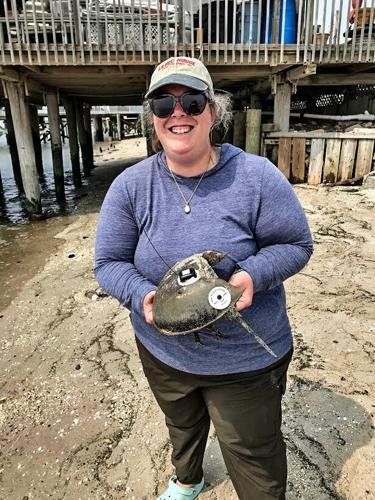Cellular Tags Track Horseshoe Crabs’ Movements | Cape May County Herald
By Karen Knight - July 15th, 2023
Quinn Whitesall-McHerron, American Littoral Society habit restoration coordinator, holds a horseshoe crab that carries a new cellular tagging device, along with a plastic tag. The tags provide information about a crab’s movement, which is used to help direct beach and ecosystem restoration efforts.
REEDS BEACH – The movements of 24 horseshoe crabs are now being monitored by cellular tracking devices in a collaborative partnership with the Cape May Point Science Center (CMPSC), Cellular Tracking Technologies (CTT), and American Littoral Society (ALS).
These tags remotely monitor and track the crabs as they come ashore and provide a better understanding on how often female crabs emerge, general horseshoe crab movement, and what informs their movement decisions.
“This information will help us focus on the beaches and restoration projects we need for the horseshoe crab to provide all it does for the ecosystem,” said Quinn Whitesall-McHerron, ALS habit restoration coordinator.
This new partnership kicked off May 23 when staff from ALS, CMPSC, and CTT, as well as CMPSC donors Rob and Wendy Wilson, had a special tagging event at Reeds Beach, along the Delaware Bay.
Donors Rob and Wendy Wilson join American Littoral Society Habitat Restoration Project Manager Shane Godshall and Sean Burcher, director of scientific operations for the Cape May Point Science Center, on Reeds Beach for the cellular tagging program.
Whitesall-McHerron said these new ‘PowerTags’ are in addition to those plastic tags ALS has been using for years that provide some basic insight on crab movement when tagged crabs are recaptured.
“We rely on people to report when they find a crab with a plastic tag,” Whitesall-McHerron said. “There isn’t any technology involved with those tags. These new tags remove that human element, so if a crab comes on shore in a remote area or wherever, the tag pings devices set up between Reeds Beach and Pierces Point Beach. We can tell where the crab is based on the strength of the ping.”
The primary goal of the new tags is to “unravel the mysteries surrounding female horseshoe crabs' behavior, particularly their emergence on a beach and their movement patterns before spawning,” added Whitesall-McHerron. “By understanding what factors inform their decisions to move, we can gain valuable insights into their reproductive cycles and overall population dynamics.”
A female horseshoe crab carrying a standard U.S. Fish and Wildlife Service recapture tag and a new Cellular Tracking Technologies ‘PowerTag.’
To gather this crucial data, tags that transmit radio telemetry data are glued to each crab's shell during the spawning season of May-June. After monitoring the crabs for an hour as the epoxy cures, they are released back into the water, ready to continue their journey. Whenever the crabs crawl ashore, their location is recorded.
“The tags do not hurt the crabs,” Whitesall-McHerron stressed. “We reached out to the U.S. Fish and Wildlife Service and several universities who have studied the horseshoe crab and there are no issues with their well-being and no impact to their spawning.”
Preliminary data has shown that the crabs tend to come ashore just after high tide events and that they can move to different beaches for spawning.
One tagged crab moved 500 meters south to Cooks Beach, another of the beaches the ALS restored following Hurricane Sandy.
Whitesall-McHerron said the cellular tagging project will expand to include more crabs next year. They typically tag about 4,000 horseshoe crabs each season with the plastic tags.



